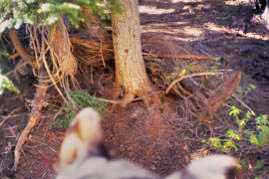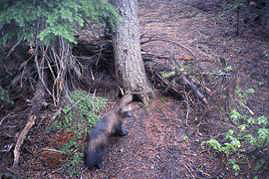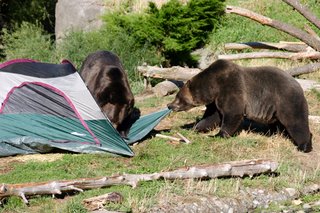Many people ask about the difference between grizzly bears and brown bears. Technically, the difference is very small. Both species are Ursus arctos (as with all brown bears around the world), but the grizzly bear is a sub-species of the North American brown bear which means that its full scientific name is Ursus arctos horribilis. Generally speaking, if you get to within 100 miles of the coast, people start referring to this species as a ‘brown bear’, otherwise ‘grizzly bear’ is the way to go.
Another key difference between the two is behavioral. It seems that coastal brown bears have an incredible and surprising ability to tolerate human presence – sometimes at very close quarters. I escort small groups of bear fans to the Katmai coast of Alaska every year and I am always astounded at the viewing opportunities that they provide for us. A great example of this is below – a picture of a female brown bear and her yearling cub – sleeping eight feet away (yes, those are my boots in the foreground!).
.jpg)
However, as I’ve spent my career teaching about bear conservation and how to behave around bears I’m compelled to share a note about these coastal brown bears and the context of the photograph above. The brown bears in this picture are on the coast of Alaska where thick runs of salmon mean that these normally solitary animals have become quite tolerant of each other over a rich food resource. In certain situations, they seem to extend that tolerance to humans, and will frequently come quite close to people during their everyday feeding activities. This is very different behavior to grizzly/brown bears (Ursus arctos) in the interior (e.g. Denali, Yellowstone, Glacier, North Cascades etc), where a much larger safety buffer is advised, and where bears don’t generally become this human-habituated over rich food resources.
Generally speaking, close-up interactions with bears should be avoided at all cost (Wildlife + Distance = Safety). In Katmai, the Park Service rules sensibly stipulate that people should not approach closer than 50 yards to any bear, or 100 yards for females with cubs. Sometimes though, the bears have other ideas! In the case above the female and cub settled down calmly next to us for a sleep, and there were an additional 23 bears within 100 yards of us at the time! Our calm, calculated response to their approach helped to ensure safety for the bears and the people.
Brown or grizzly? Either way, interactions with bears can vary immensely and a knowledge of bear behavior is essential when determining the best course of action.
For more information on bear safety, please go to the GBOP website: www.bearinfo.org/bearsafety.htm
Written by Chris Morgan, GBOP Co-Director, bear researcher & conservationist chrismorgan@insightwildlife.com




